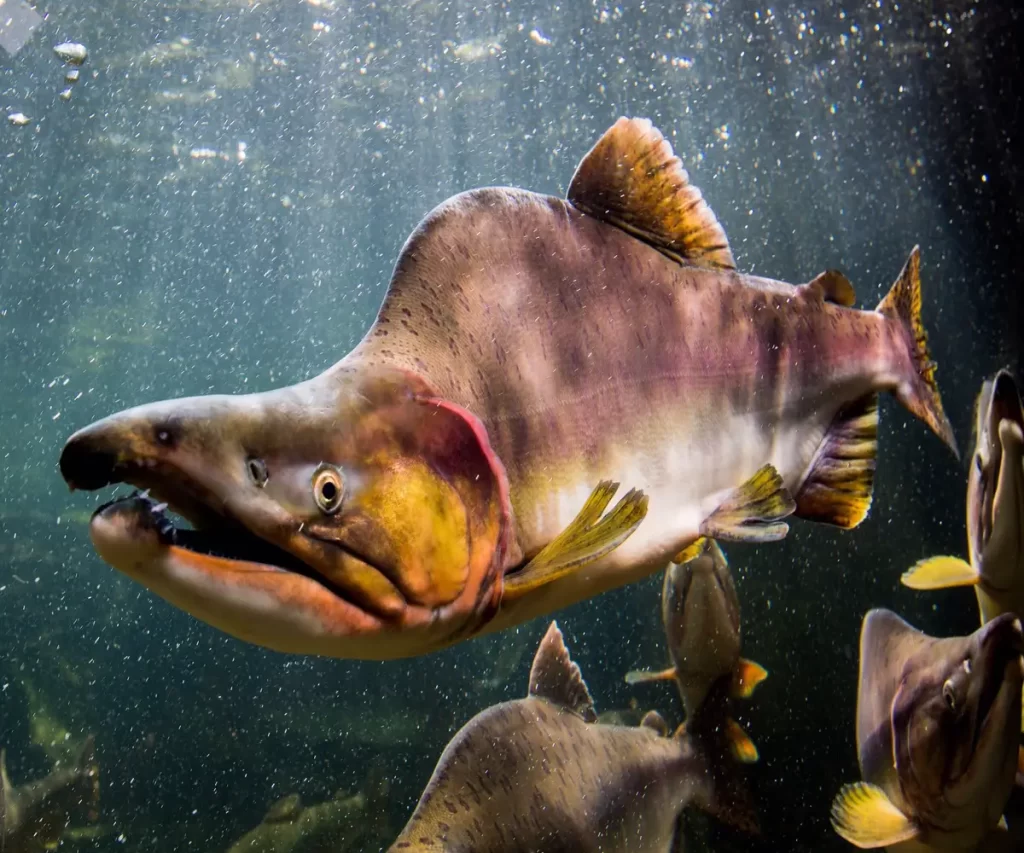
Pink Salmon Fish Species Guide
The Pink Salmon, scientifically known as Oncorhynchus gorbuscha, is a captivating and economically significant fish species that inhabits the Pacific Ocean. Also commonly referred to as “humpback” or “humpie” salmon due to the distinctive hump that develops on their backs during spawning, Pink Salmon play a crucial role in the ecological balance of their native ecosystems. In this comprehensive exploration, we delve into the various aspects of Pink Salmon, including their biology, life cycle, ecological importance, economic impact, and conservation efforts.
Biology of Pink Salmon
Physical Characteristics
Pink Salmon are easily recognizable by their characteristic silver bodies with a hint of blue or green on their backs. During the spawning season, males undergo a remarkable transformation, developing a pronounced hump on their backs, elongated jaws, and a striking coloration that ranges from olive green to red. Females also display changes in coloration, taking on a vibrant pink or red hue.
Size and Weight
On average, Pink Salmon measure between 20 to 25 inches in length and weigh approximately 3 to 5 pounds. However, variations exist among individual fish and different populations.
Habitat
Pink Salmon have a vast distribution and are primarily found in the North Pacific Ocean. They inhabit coastal waters, estuaries, and rivers, with specific populations localized to particular regions. Notably, Pink Salmon are known for their ability to adapt to a wide range of environments, from small streams to larger river systems.
Life Cycle of Pink Salmon
Spawning
The life cycle of Pink Salmon is a fascinating journey that begins with spawning. Unlike other Pacific salmon species that have a longer freshwater residency, Pink Salmon typically spend only two years in the ocean before returning to their natal streams to spawn. Spawning occurs in shallow streams and rivers during the late summer or fall.
Fry and Parr Stages
After hatching from their eggs, Pink Salmon enter the fry stage, where they remain in freshwater for a short period, feeding on aquatic insects. As they grow, they transition into the parr stage, developing distinct markings along their sides.
Ocean Migration
One of the unique features of Pink Salmon is their rapid ocean migration. Within a few months of entering the ocean, they cover extensive distances, sometimes traveling thousands of miles in search of food. Their diet primarily consists of small crustaceans, plankton, and small fish.
Return to Spawn
Upon reaching sexual maturity, usually after two years in the ocean, Pink Salmon instinctively return to their natal streams to spawn. This homing behavior is a remarkable aspect of their life cycle and plays a crucial role in maintaining distinct populations.
Ecological Importance
Nutrient Cycling
The annual migration of Pink Salmon from the ocean to freshwater ecosystems has profound ecological implications. As these fish return to spawn and eventually die, their carcasses provide a nutrient boost to the surrounding environment. The decaying bodies release essential nutrients into the water, benefiting both aquatic and terrestrial ecosystems.
Keystone Species
Pink Salmon are considered a keystone species, meaning they have a disproportionately large impact on their ecosystem relative to their abundance. Their influence extends to various species, from insects to larger predators, shaping the structure and dynamics of the ecosystems they inhabit.
Predators and Prey Relationships
Throughout their life cycle, Pink Salmon serve as both predators and prey. In the ocean, they are preyed upon by marine mammals, birds, and larger fish species. Upon returning to freshwater, they become a vital food source for bears, eagles, and other predators, contributing to the intricate web of predator-prey relationships.
Economic Impact
Commercial Fishing
Pink Salmon are commercially valuable and support significant fisheries in regions like Alaska, Russia, and Canada. The high abundance of Pink Salmon makes them an essential resource for the fishing industry. The commercial value extends to various products, including canned salmon, frozen fillets, and roe.
Recreational Fishing
Beyond commercial fishing, Pink Salmon also attract recreational anglers. Angling for Pink Salmon is a popular activity in areas where their runs occur, contributing to local economies through tourism and sport fishing.
Conservation Challenges and Efforts
Habitat Degradation
The conservation of Pink Salmon faces challenges related to habitat degradation. Urbanization, pollution, and climate change can negatively impact the quality of freshwater habitats essential for Pink Salmon spawning.
Overfishing Concerns
While Pink Salmon are known for their abundance, overfishing remains a concern. Sustainable management practices are crucial to ensure the long-term health of Pink Salmon populations and the ecosystems they inhabit.
Climate Change
Climate change poses a significant threat to Pink Salmon and their habitats. Rising temperatures, changes in ocean currents, and altered precipitation patterns can disrupt their life cycle and migration patterns.
Conservation Initiatives
Numerous conservation initiatives aim to address the challenges facing Pink Salmon. These include habitat restoration projects, sustainable fisheries management, and efforts to mitigate the impacts of climate change on their ecosystems.
Conclusion to: Pink Salmon
In conclusion, the Pink Salmon, with its unique life cycle, ecological significance, and economic importance, stands as a testament to the interconnectedness of aquatic ecosystems. Understanding and appreciating the intricacies of this species contribute not only to the preservation of Pink Salmon but also to the overall health of the ecosystems they inhabit. As we navigate the challenges posed by habitat degradation and climate change, the conservation of Pink Salmon becomes a symbol of our commitment to maintaining the biodiversity and resilience of our planet’s precious aquatic environments.